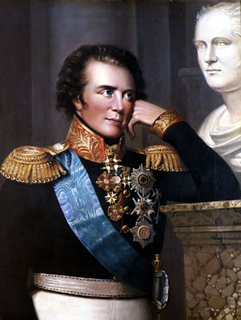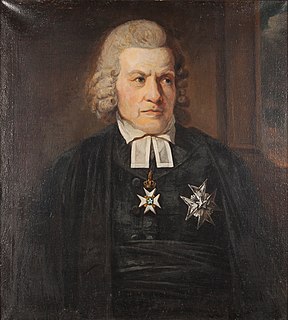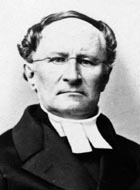
Mikael Agricola was a Finnish Lutheran clergyman who became the de facto founder of literary Finnish and a prominent proponent of the Protestant Reformation in Sweden, including Finland, which was a Swedish territory at the time. He is often called the "father of literary Finnish".

Count Gustaf Mauritz Armfelt was a Finnish-Swedish-Russian courtier and diplomat. In Finland, he is considered one of the greatest Finnish statesmen. His advice to Russia's Tsar Alexander I was of utmost importance for securing the autonomy of the Grand Duchy of Finland.
Turku and Pori Province was a province of independent Finland from 1917 to 1997. The province was however founded as a county in 1634 when today's Finland was an integrated part of Sweden. It is named after the cities of Turku and Pori.

Johan Gadolin was a Finnish chemist, physicist and mineralogist. Gadolin discovered a "new earth" containing the first rare-earth compound yttrium, which was later determined to be a chemical element. He is also considered the founder of Finnish chemistry research, as the second holder of the Chair of Chemistry at the Royal Academy of Turku. Gadolin was ennobled for his achievements and awarded the Order of Saint Vladimir and the Order of Saint Anna.

The Archbishop of Uppsala has been the primate of Sweden in an unbroken succession since 1164, first during the Catholic era, and from the 1530s and onward under the Lutheran church.

Frans Michael Franzén was a Swedish-Finnish poet and clergyman. He served as the Bishop of the Diocese of Härnösand.

Jakob Gadolin was a Swedish Lutheran bishop, professor of physics and theology, politician and statesman.

Isaacus Rothovius was the Bishop of Turku from 1627 till 1652.

Lars Gabriel von Haartman was a Swedish-speaking Finnish politician. Along with Count Gustaf Mauritz Armfelt, he was one of the most prominent politicians who were in favour of developing Finland as part of the Russian Empire instead of striving towards independence.

Johannes Gezelius the younger, also known as Johannes Gezelius den yngre in Swedish and Johannes Gezelius nuorempi in Finnish, was a theologian, professor at the Royal Academy of Åbo and Bishop of Turku between 1690 and 1718.

Olof Samuel Tempelman was a Swedish architect and, from 1779, professor at the Royal Swedish Academy of Arts. He was appointed royal architect in 1799.

In Finnish history, Finland under Swedish rule is the historical period when the bulk of the area that later came to constitute Finland was an integral part of Sweden. The starting point of Swedish rule is uncertain and controversial. Historical evidence of the establishment of Swedish rule in Finland exists from the late 13th century onwards.

Charles (Carlo) Francesco Bassi was a Finnish architect of Italian descent. He was the first professionally trained architect who permanently worked in present-day Finland. He worked, both as an independent architect and as an official responsible for planning new churches, in a Neoclassical style.

Johannes Elai Terserus was a Swedish prelate and theologian who served as the Bishop of Turku from 1658 till 1664 and then Bishop of Linköping between 1671 and 1678.

Herman Witte was the Bishop of Turku from 1721 to 1728.
Lars Tammelin also known as Laurentius Gabrielis Tammelinus was a Finnish mathematician and prelate who was the Bishop of Turku from 1728 to 1733.
Jonas Fahlenius was a Swedish philosopher, theologian and Bishop of Turku from 1734 till 1746.
The history of Finnish philosophy ranges from the prehistoric period to contemporary philosophy.

Henrik Heikel was a Finland-Swedish educator and priest.
















